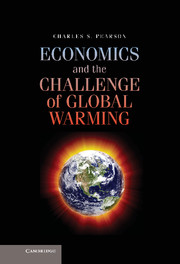Book contents
- Frontmatter
- Contents
- Acknowledgments
- Introduction and a Road Map
- 1 Climate Change
- 2 The Role of Benefit Cost in Climate Policy
- 3 Discounting and Social Weighting (Aggregating over Time and Space)
- 4 Empirical Estimates
- 5 Strategic Responses
- 6 Targets and Tools
- 7 Trade and Global Warming
- 8 The Challenge of International Cooperation
- 9 Beyond Kyoto
- 10 A Summing-Up
- Index
- References
6 - Targets and Tools
Published online by Cambridge University Press: 05 June 2012
- Frontmatter
- Contents
- Acknowledgments
- Introduction and a Road Map
- 1 Climate Change
- 2 The Role of Benefit Cost in Climate Policy
- 3 Discounting and Social Weighting (Aggregating over Time and Space)
- 4 Empirical Estimates
- 5 Strategic Responses
- 6 Targets and Tools
- 7 Trade and Global Warming
- 8 The Challenge of International Cooperation
- 9 Beyond Kyoto
- 10 A Summing-Up
- Index
- References
Summary
The policy process typically identifies objectives, establishes targets, and selects tools or instruments to attain the targets. This chapter is mainly concerned with the tools for achieving climate policy objectives and targets. This involves a discussion of the putative advantages of market-friendly tools that use incentives and disincentives to limit greenhouse gas emissions versus regulatory tools. It also involves evaluating the three main types of market-oriented tools: taxes, cap-and-trade schemes, and subsidies. Before starting this discussion, however, it is useful to compare two types of emissions targets. As described in Chapter 9, both types are found in the Copenhagen Accord commitments and are causing some confusion.
Absolute versus Intensity Targets
Emissions of greenhouse gases are the control variable in climate policy. Emissions targets can be set in absolute quantities or in relative terms. Absolute targets are expressed in tons of CO2e and can be set at the sector, national, or global level. Relative targets are commonly known as intensity targets and are set at either the sector or national level. We are mainly interested in national-level absolute targets and in national-level intensity targets expressed per unit GDP – that is, tons of emissions per million dollars of GDP.
- Type
- Chapter
- Information
- Economics and the Challenge of Global Warming , pp. 124 - 142Publisher: Cambridge University PressPrint publication year: 2011



